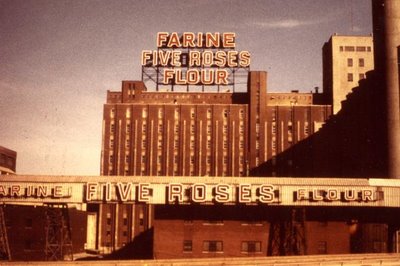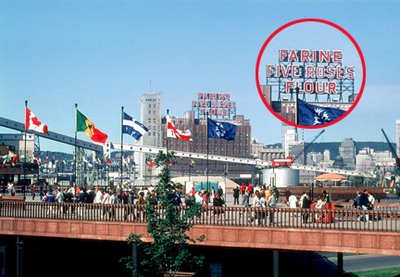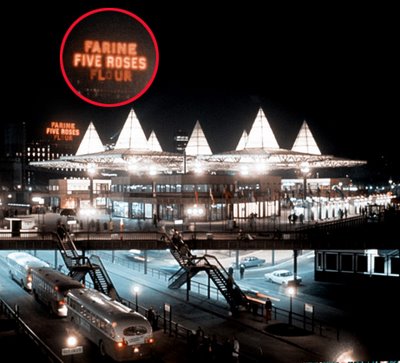 The neon Five Roses Flour sign is a Montreal landmark. Erected in 1948 atop the Ogilvie flour mill in the Old Port, the original sign read "Farine Ogilvie Flour", named after the Scottish family that owned the mill. The sign was changed in 1954 in favor of advertising the Five Roses brand of flour rather than the Ogilvie family business.
The neon Five Roses Flour sign is a Montreal landmark. Erected in 1948 atop the Ogilvie flour mill in the Old Port, the original sign read "Farine Ogilvie Flour", named after the Scottish family that owned the mill. The sign was changed in 1954 in favor of advertising the Five Roses brand of flour rather than the Ogilvie family business.The sign read "Farine Five Roses Flour" for over 20 years, until the Bill 101 language law forced the removal of the English word "flour" in 1977. (Ironically, the English words "Five Roses" are acceptable to the French-only law because they're a brand name. This type of linguistic duality is totally representative of Montreal...) The sign's final transformation in 1977 is what we still see today: "Farine Five Roses".
In 1993, the Ogilvie Flour business was sold to U.S. multinational Archer Daniels Midland (ADM), who sold it to the J.M. Smucker co. earlier this year (2006). ADM still owns the building atop which the sign is perched, and, naturally, doesn't want to continue promoting a brand it no longer owns. The sign was then switched off, with plans of dismantling it.
Public outcry from Montreal citizens and heritage activists lead to the sign being switched back on, temporarily, until it's owners make a final decision regarding it's future. The city of Montreal refuses to get involved because the sign is private property. It is also in a state of disrepair, and would require major investing for it's restoration. The outlook looks bleak...
I consider the Five Roses sign a piece of industrial art and not simply advertising. It hearkens back to the golden days of Montreal neon signage. It must be saved, it's as much a landmark as the illuminated cross on Mount Royal. To lose the Five Roses sign would be to lose a part of Montreal history...
...
The Five Roses sign is located in close proximity to where the main entrance of Expo 67 was. I have come across 2 photos from Expo where we see the Five Roses sign (pre-Bill 101, with the word "flour" still intact...)

 Click here to view Five Roses T-shirts on sale at Montréalité.com. Click here to try the Five Roses anagram game, via the Save Farine Five Roses blog.
Click here to view Five Roses T-shirts on sale at Montréalité.com. Click here to try the Five Roses anagram game, via the Save Farine Five Roses blog.images: (top, circa 1950's) savefarinefiveroses.org
(bottom, Expo 67) FOS Productions



















